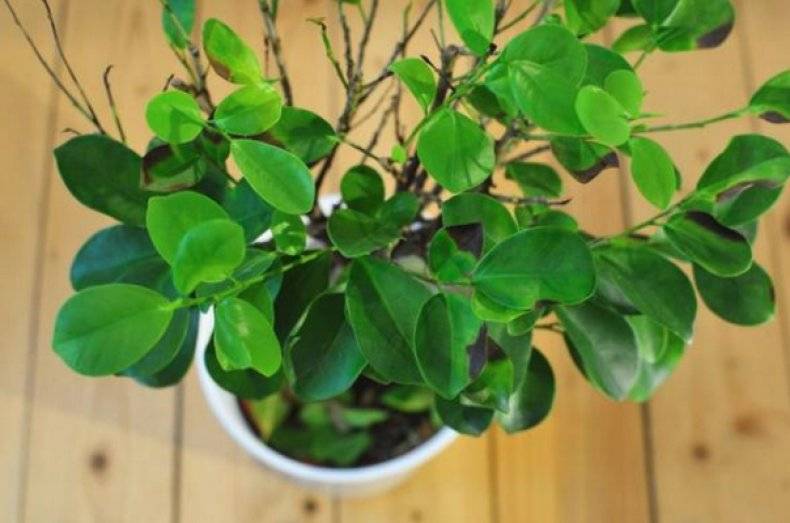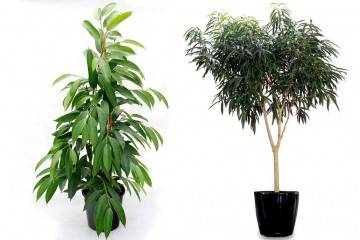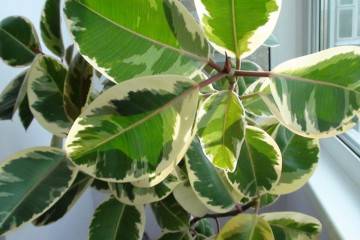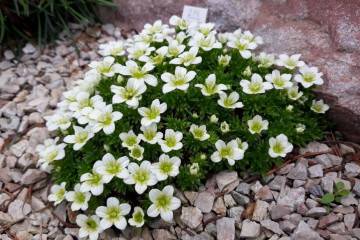Ficus microcarpa - care and reproduction at home
Content:
Ficus microcarpa is an inhabitant of tropical forests, which got its name from its small fruits. The plant itself in nature is capable of growing to impressive sizes. For decorative purposes, this ficus is popular for its root system, which is capable of intertwining using the bonsai technique, and also for its dense, beautiful crown.
Description of the flower
Ficus microcarpa (Ficus Microcarpa) is an ornamental tree often called bonsai. Its main feature is the binding of roots, which rise above the ground and form different shapes. The lush crown also has a spectacular look.
Under natural conditions, the plant grows in the tropical forests of Australia, China and Asia, preferring a well-lit area. In nature, it reaches 20-23 m in height, when in indoor conditions it rarely exceeds 2-2.5 m.
Microcarp leaves have a smooth lanceolate-oval surface and slightly curved tips. On close inspection, it may appear that the surface is covered with wax. Leaves are painted green or dark green. The bark is brown. Under natural conditions, fruits grow yellow, which after ripening is replaced by burgundy.
Microcarp varieties
In ornamental cultivation, the following varieties can be used:
- Ginseng. If in nature this variety behaves aggressively relative to other plants, then this does not happen in home cultivation. Ficus can multiply by seed, giving growers the opportunity to grow a real bonsai with bizarre roots;
- Moklame. Dwarf ficus, loved by modern flower growers. Differs in graceful shoots and a solid crown. Sun-loving variety, therefore requires additional lighting in winter;
- Variegata. Variegated variety with high decorative qualities. It can be in the form of a lush bush or grown using the bonsai technique.
- Westland. A type of microcarp with small leaves growing only 10 cm in length. An unpretentious variety that can grow in the form of a bush.
Features of plant care
Caring for ficus microcarp is quite simple, since it is unpretentious. However, if the recommendations are not followed, the plant may stop growing and lose its decorative qualities.
Temperature
Microcarpa prefers to grow in a room with a moderate temperature of 20 ° C to 24 ° C. In a hotter room, it will be necessary to organize frequent ventilation and the supply of fresh air. At the same time, the ficus does not like drafts, as well as sharp drops.
Lighting
This type of ficus is especially fond of good lighting: it can be sunlight or phytolamp. The best location for the pot would be near the window, but away from the heating system.
Watering
Abundant watering is recommended in the active growth phase. The frequency will depend on the rate of drying of the topsoil.
Spraying
The cultivation of microcarp involves the organization of high humidity. To do this, spraying with standing water should be done every 1-2 days.
Humidity
The need for high humidity implies, in addition to spraying, regular wiping with a damp cloth on the sheet metal. In the summer, you can arrange a warm shower for the plant.
Priming
For comfortable growth, ficus needs a soft and fertile soil with a neutral acidity level. You can plant it in a ready-made composition or make it yourself.
Top dressing
During the growing season, fertilize should be applied every two weeks. For this purpose, complex formulations for hardwood or bonsai can be used.
Features of winter care
In winter, the procedure for caring for a home ficus may be slightly different. So, the frequency of watering should depend on the temperature in the room and the availability of lighting. In cool rooms, soil moisture is significantly reduced, when in warm and lit rooms it remains at the same level.
Ficus flowering
During the flowering period, the ficus is covered with syconia - spherical flowers that look more like berries. In the process of their development, small fruits are formed that acquire a crimson hue. Home ficus blooms extremely rarely, and the flowers themselves do not degenerate into berries without pollination. Many growers remove syconia in a timely manner to preserve the strength of the plant.
Pruning
To improve the decorative properties of microcarp, it is recommended to carry out formative pruning. It is better to start it as early as possible in order to give the flower the desired shape during the growth process.
Reproduction methods
Ficus can be propagated in three ways, each of which has its own characteristics.
- Propagation by cuttings. It is necessary to cut off the upper shoot-cutting, partially covered with hard bark. Then, for a day, it is placed in water with the addition of coal or ash. After the appearance of the roots, planting in the ground follows. The cuttings itself is covered with a jar. You can remove it after the leaves appear.
- Reproduction by layering. To obtain this planting material, the lower branch of the trunk is selected at a distance of 50-60 cm from the top. Then there is a partial cut of the bark, the application of wet moss and careful winding. After a month, roots will begin to appear at the cut site. A sprig of ficus, together with the roots, is carefully cut at an acute angle and planted in a separate pot.
- Seeds. Ficus can be propagated in the form of bonsai only with purchased seeds. They must be of high quality, otherwise you can not wait for their germination. Before sowing them, the seeds are soaked for 1-2 days in warm water. Planting is carried out in fertile soil to a depth of no more than 1 cm, and then everything is covered with a film.
Transfer
Ficus microcarp does not tolerate soil changes, so its transplant is possible no more than once every 2-3 years. It is better to plan the procedure in the spring and it is not necessary to change the pot. The plant will tolerate this procedure better if it remains in the same container.
Possible problems
When growing homemade microcarp, problems should not arise, since the plant is resistant to many diseases and pests. However, with the wrong growing conditions or with inadequate care, some difficulties can arise.
- Gray spots appear on the leaves. This problem occurs with an excess of moisture, when the decay process begins in the root system.
- Frequent leaf changes. It is often observed with a lack of moisture and dry air. Also, the reason may lie in drafts and rearrangement of the plant from place to place.
- Darkening of sheet plates.A frequent symptom of a sunburn. They may also curl.
Of the insect pests, the plant is characterized by the appearance of a spider mite, which is facilitated by dry indoor air. You can remove it yourself using a damp cloth or a washcloth dipped in soapy water.
Signs and superstitions
Homemade figs, including microcarp, are accompanied by interesting superstitions:
- the plant tidies up the energy of the house, improving comfort;
- eliminates the negative atmosphere and energy with which ill-wishers and envious people could come to visit;
- growing ficus in an office building improves the performance of employees.
Ficus microcarp is a popular plant that even beginners can take care of. These flowers, grown from seeds, deserve special attention. In the process of their development, interesting designs in the bonsai technique can be obtained from the root system.




















